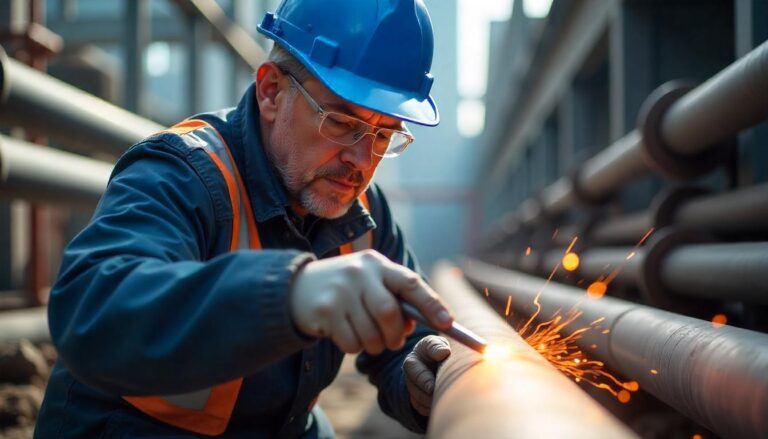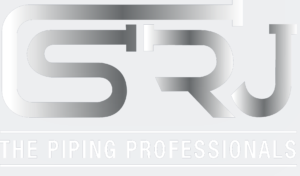Visual Inspection: Best Practices for Pipe Fabrication
Table of Contents
In the intricate world of pipe fabrication, where precision and reliability are paramount, visual inspection stands as the first line of defense against potential flaws and failures. The integrity of piping systems is crucial across numerous industries, including oil and gas, as well as pharmaceuticals, which impacts safety, efficiency, and environmental protection.
However, the increasing complexity of industrial projects, coupled with stringent regulatory demands, presents significant challenges in maintaining impeccable quality. This expert guide offers authoritative knowledge and strategic clarity, enabling senior engineers, project directors, and facility owners to enhance their pipe fabrication processes and achieve flawless results.
By delving into advanced methodologies, risk mitigation strategies, and future outlooks, this guide empowers readers to make informed decisions and drive long-term success in their industrial endeavors.
The Evolving Industrial Landscape
Several macro-trends are reshaping the industrial piping landscape, demanding a more rigorous and strategic approach to visual inspection.

Regulatory Shifts
Increasingly stringent environmental and safety regulations, such as those issued by the Environmental Protection Agency (EPA) and the Occupational Safety and Health Administration (OSHA), are driving demand for enhanced quality control measures in the pipe fabrication industry. Non-compliance can result in hefty fines, project delays, and reputational damage.
Digital Transformation
The integration of digital technologies, such as Building Information Modeling (BIM), cloud-based data management, and advanced sensor technologies, is revolutionizing pipe fabrication. These technologies enable real-time monitoring, predictive maintenance, and enhanced traceability, thereby improving the effectiveness of visual inspection processes.
Sustainability Demands
The growing emphasis on sustainable practices is prompting industries to adopt eco-friendly materials and fabrication techniques. This includes utilizing recycled materials, minimizing waste generation, and reducing energy consumption. Visual inspection plays a critical role in ensuring the quality and durability of these sustainable piping systems.
Aging Infrastructure
A significant portion of industrial infrastructure is aging, which increases the risk of corrosion, leaks, and failures. Regular and thorough visual inspections are crucial for identifying potential problems early and preventing costly and potentially catastrophic incidents.
Skilled Labor Shortage
The shortage of skilled welders, inspectors, and fabricators is a growing concern in the industry. This necessitates the development of more efficient and effective training programs, as well as the adoption of automated inspection technologies to augment human capabilities.
Strategic Imperatives for Pipe Fabrication Visual Inspection
To navigate the evolving industrial landscape and ensure flawless pipe fabrication, industrial leaders must prioritize the following strategic imperatives:
Comprehensive Inspection Planning
Detailed Planning: Develop a comprehensive inspection plan that outlines the scope, frequency, and methods of visual inspections at each stage of the pipe fabrication process. This plan should be tailored to the specific requirements of the project and comply with relevant industry standards and regulations.
Risk-Based Approach: Adopt a risk-based approach to prioritize inspections based on the criticality of the piping system and the potential consequences of failure. Focus on high-risk areas, such as welds, joints, and areas prone to corrosion.
Documentation and Traceability: Maintain thorough documentation of all visual inspections, including inspection reports, photographs, and videos. This documentation should be readily accessible and traceable to the specific pipe spools and components.
Long-Term Benefits: Minimizes risk of failures, ensures regulatory compliance, and reduces long-term maintenance costs.
Skilled Workforce Development
Training and Certification: Invest in comprehensive training programs to develop a skilled workforce of visual inspectors. Ensure that inspectors are certified to relevant industry standards, such as AWS Certified Welding Inspector (CWI) or API 510 Pressure Vessel Inspector.
Continuous Improvement: Foster a culture of continuous improvement by providing ongoing training and development opportunities for inspectors. Keep them updated on the latest inspection techniques, tools, and industry best practices.
Knowledge Transfer: Implement knowledge transfer programs to capture and share the expertise of experienced inspectors with younger generations. This can include mentoring programs, on-the-job training, and internal knowledge repositories.
Long-Term Benefits: Enhances inspection accuracy, reduces human error, and ensures consistent quality.
Advanced Technology Adoption
Borescopes and Endoscopes: Utilize borescopes and endoscopes to inspect internal surfaces of pipes and welds, identifying defects that are not visible to the naked eye.
Digital Photography and Videography: Employ high-resolution digital cameras and video recorders to capture detailed images and videos of inspected areas. This allows for remote review, analysis, and documentation of findings.
Automated Visual Inspection Systems: Implement automated visual inspection systems that use machine vision and artificial intelligence to detect defects with high accuracy and speed. These systems can be integrated into the fabrication process to provide real-time feedback and prevent defects from propagating.
Long-Term Benefits: Improves inspection efficiency, enhances defect detection, and reduces reliance on manual labor.
Adherence to Industry Standards and Regulations
Compliance: Ensure that all visual inspection activities comply with relevant industry standards and regulations, such as ASME B31.3 Process Piping, API 5L Specification for Line Pipe, and ISO 9001 Quality Management Systems.
Third-Party Verification: Engage independent third-party inspection agencies to verify the quality of pipe fabrication and ensure compliance with applicable standards.
Audits and Assessments: Conduct regular internal and external audits to assess the effectiveness of the visual inspection program and identify areas for improvement.
Long-term benefits include ensuring legal compliance, enhancing product reliability, and improving customer satisfaction.
Advanced Methodologies & Innovations
Several cutting-edge technologies and methodologies are redefining visual inspection in pipe fabrication:
- AI-Powered Defect Detection: Artificial intelligence (AI) algorithms can be trained to automatically detect and classify defects in pipe welds and surfaces based on visual data. This technology significantly improves the accuracy and efficiency of visual inspection, reducing the risk of human error.
- Digital Radiography: Digital radiography replaces traditional film-based radiography with digital detectors, providing higher resolution images, faster processing times, and reduced radiation exposure. This technology enables more detailed and accurate inspection of welds and materials.
- Laser Scanning: Laser scanning technology enables the creation of 3D models of pipes and welds, providing precise dimensional measurements and facilitating the detection of defects. This technology is beneficial for inspecting complex geometries and identifying deviations from design specifications.
- Smart Sensors: Smart sensors can be embedded into pipes to monitor their condition in real-time, providing early warning of potential problems such as corrosion, leaks, and cracks. These sensors can be integrated with visual inspection programs to provide a more comprehensive assessment of pipe integrity.
- Drones and Robotics: Drones and robots equipped with high-resolution cameras and sensors can be used to inspect hard-to-reach areas of piping systems, such as elevated pipelines and confined spaces. This technology reduces the risk of human injury and improves the efficiency of inspection.

Risk Mitigation & Resilience Strategies
To ensure long-term resilience and mitigate high-stakes risks in pipe fabrication projects, consider these strategies:
- Redundancy and Diversification: Implement redundancy in critical piping systems to prevent a single point of failure from leading to a catastrophic event. Diversify material selection to reduce the risk of corrosion and other material-related failures.
- Preventive Maintenance Programs: Develop and implement comprehensive preventive maintenance programs that include regular visual inspections, cleaning, and lubrication of piping systems to ensure optimal performance and longevity. This helps to identify and address potential problems before they escalate into major failures.
- Emergency Response Plans: Develop detailed emergency response plans that outline the steps to be taken in the event of a pipe failure or other emergency. This plan should include procedures for containment, evacuation, and communication with relevant stakeholders.
- Cybersecurity Measures: Implement robust cybersecurity measures to protect piping systems from cyberattacks that could compromise their integrity and safety. This includes firewalls, intrusion detection systems, and regular security audits.
- Insurance Coverage: Obtain adequate insurance coverage to protect against potential losses resulting from pipe failures or other incidents. This coverage should include property damage, business interruption, and liability claims.
Future Outlook & Expert Predictions
Looking ahead, the field of visual inspection in pipe fabrication is poised for significant advancements:
- Increased Automation: The adoption of automated visual inspection systems is expected to continue accelerating, driven by advancements in AI, machine vision, and robotics. These systems will become more sophisticated and capable of detecting a wider range of defects with higher accuracy and speed.
- Remote Inspection Technologies: Remote inspection technologies, such as drones, robots, and virtual reality (VR) systems, will become increasingly prevalent, enabling inspectors to remotely assess the condition of piping systems in hazardous or difficult-to-access locations.
- Data Analytics and Predictive Maintenance: Data analytics and predictive maintenance techniques will be used to analyze visual inspection data and predict potential failures before they occur. This will enable proactive maintenance and prevent costly downtime.
- Digital Twins: Digital twins, which are virtual replicas of physical piping systems, will be utilized to simulate operating conditions and assess the potential impact of defects. This will enable engineers to make more informed decisions about maintenance and repairs.
- Sustainability Focus: Visual inspection will play an increasingly important role in ensuring the sustainability of piping systems by identifying opportunities to reduce waste, conserve energy, and extend the lifespan of materials.
Conclusion
In conclusion, visual inspection is a cornerstone of quality control in pipe fabrication, ensuring the integrity and reliability of piping systems across various industries. By prioritizing comprehensive inspection planning, skilled workforce development, the adoption of advanced technology, and adherence to industry standards, industrial leaders can mitigate risks, enhance efficiency, and achieve flawless results.
As the industrial landscape continues to evolve, driven by regulatory shifts, digital transformation, and sustainability demands, the importance of strategic visual inspection will only increase.
Schedule a strategic consultation with SRJ Piping India’s experts to optimize your pipe fabrication processes and ensure long-term success. Partner with us for your next visionary project.
In summary, implementing rigorous visual inspection protocols is paramount for ensuring the integrity, safety, and longevity of pipe fabrication systems. By adhering to industry best practices—such as pre-fabrication checks, weld scrutiny, and compliance with standards like ASME B31.3—fabricators can preempt costly failures and enhance operational reliability. For deeper insights into maintaining piping excellence, explore our resources on piping quality control and corrosion protection. Additionally, refer to authoritative external guides on welding inspection techniques and pipeline integrity assessment.
Suggested Links to read:
Suggested Links to read:
NFPA Fire Safety Standards (Global authority on fire protection codes)
OSHA Fire Safety Guidelines (U.S. regulatory framework for industrial safety)
Need Expert Insight on Pipe Fabrication Inspections?
SRJ Piping India helps engineering leaders implement best-in-class visual inspection protocols to meet quality, compliance, and performance standards in complex industrial projects.
